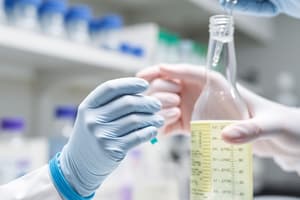Podcast
Questions and Answers
What is the primary purpose of aseptic technique in microbiology?
What is the primary purpose of aseptic technique in microbiology?
- To enhance microbial growth
- To prevent contamination (correct)
- To simplify laboratory procedures
- To increase exposure to air
The inoculating loop should be sterilized only after it has been used to transfer the microbial sample.
The inoculating loop should be sterilized only after it has been used to transfer the microbial sample.
False (B)
What is the purpose of working near a flame during aseptic technique?
What is the purpose of working near a flame during aseptic technique?
To reduce the chance of airborne microbes contaminating the work.
The process of introducing microorganisms into a sterile culture medium is called _______.
The process of introducing microorganisms into a sterile culture medium is called _______.
Match the following steps to their correct aseptic technique actions:
Match the following steps to their correct aseptic technique actions:
What is the goal of streaking for isolation?
What is the goal of streaking for isolation?
The inoculating loop should be cooled immediately after sterilization before collecting the microbial sample.
The inoculating loop should be cooled immediately after sterilization before collecting the microbial sample.
What type of medium is commonly used in microbiology for inoculation?
What type of medium is commonly used in microbiology for inoculation?
After inoculation, the media should be _______ and placed in an incubator.
After inoculation, the media should be _______ and placed in an incubator.
Which method is used to streak the agar plate in the streaking for isolation process?
Which method is used to streak the agar plate in the streaking for isolation process?
Flashcards are hidden until you start studying
Study Notes
Aseptic Technique
- Aims to prevent contamination during microbiological work, ensuring reliable results.
- Key procedures involve the sterilization of tools, typically via heat (Bunsen burner) or chemical disinfectants.
- Working near a flame creates an upward air flow, minimizing the risk of airborne microbial contamination.
- Reducing exposure time of cultures and sterile equipment to air is crucial to maintain sterility.
- Work surfaces must be disinfected with alcohol-based agents before and after use to prevent cross-contamination.
Media Inoculation
- This process involves introducing microorganisms into a sterile growth medium.
- The inoculating loop or needle must be sterilized by passing it through a flame until it glows red-hot, then allowed to cool.
- A small amount of microbial sample is picked up using the cooled sterilized loop.
- Inoculation involves transferring the sample to the growth medium (agar plates, broth tubes) using streaking or dipping methods.
- After inoculation, the media must be sealed and incubated at an appropriate temperature for microbial growth.
Streaking for Isolation
- A technique used to separate and isolate individual bacterial colonies from a mixed sample.
- The objective is to thin out bacteria on an agar plate to obtain isolated colonies for further study.
- Materials required include sterile petri dish with nutrient agar, inoculating loop, Bunsen burner, and microbial sample.
- Initial step involves sterilizing the inoculating loop in a flame until red-hot, letting it cool without contact.
- The cooled loop is dipped into the microbial sample for inoculation.
- Using the Quadrant Method, the first quadrant of the agar plate is streaked gently in a back-and-forth motion in one small section.
Studying That Suits You
Use AI to generate personalized quizzes and flashcards to suit your learning preferences.




